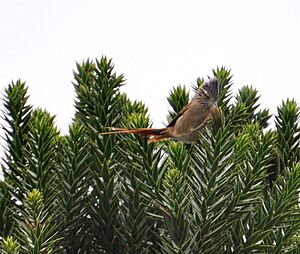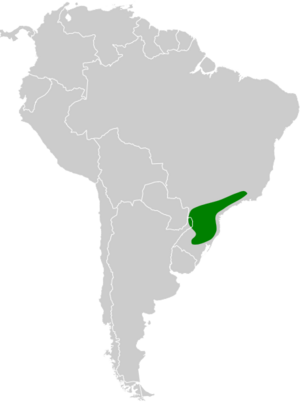Araucaria tit-spinetail facts for kids
The Araucaria tit-spinetail (Leptasthenura setaria) is a special kind of bird that lives in Argentina and Brazil. It's called "Near Threatened," which means it's a bit rare and needs our help to protect its home. This little bird is part of the ovenbird family, known for their unique nests.
Quick facts for kids Araucaria tit-spinetail |
|
|---|---|
 |
|
| Conservation status | |
| Scientific classification | |
| Genus: |
Leptasthenura
|
| Species: |
setaria
|
 |
|
Contents
About the Araucaria Tit-Spinetail
Why the Name "Araucaria"?
The Araucaria tit-spinetail gets its name from a special tree called the Araucaria angustifolia, also known as the "Brazilian pine." This bird relies completely on these trees for its home and food.
Bird Family and Grouping
For a while, scientists thought this bird belonged to its own group. But in 2011, new research showed it's actually part of the Leptasthenura group. This means it's closely related to other "tit-spinetails."
What Does the Araucaria Tit-Spinetail Look Like?
This bird is quite small, about 17 to 19 centimeters (7 to 7.5 inches) long. It weighs around 11 grams (0.4 ounces), which is about the same as a few paper clips!
- Body Shape: It has a small body and a long tail. It also has a short crest on its head and a slightly curved beak.
- Colors: Both male and female birds look alike. They have a thin white stripe above their eyes, with a black and white striped face.
- Head and Back: Their head and crest are dark, with faint lighter stripes. Their upper body is reddish-brown.
- Wings and Tail: Their wings are mostly reddish, and their tail is also reddish-brown. The tail is deeply forked, almost like a "V" shape.
- Underparts: Their throat and upper chest are whitish with dark stripes. Their lower chest and belly are a warm, yellowish-brown color.
- Eyes, Beak, and Legs: Their eyes can be brown or gray. Their beak is dark with a lighter base, and their legs and feet are grayish-green.
- Young Birds: Young Araucaria tit-spinetails have less clear patterns and fewer stripes on their heads.
Where Does the Araucaria Tit-Spinetail Live?
This bird lives in parts of Brazil and Argentina. You can find them in southern Brazil, from Minas Gerais and Rio de Janeiro states, all the way down to Rio Grande do Sol. They also live in northern Argentina's Misiones Province.
Its Special Home: The Araucaria Tree
The Araucaria tit-spinetail lives almost entirely in Araucaria angustifolia trees. These trees can be found in many places, like:
- Forests
- Woodlands
- Small groups of trees
- Gardens
- Plantations
They usually live at elevations between 750 and 1400 meters (2,460 to 4,600 feet) high. Sometimes, they can even be found as high as 2000 meters (6,560 feet)!
How Does the Araucaria Tit-Spinetail Behave?
Staying in One Place
The Araucaria tit-spinetail is a "resident" bird. This means it stays in the same area all year round and doesn't migrate to other places.
What Does It Eat?
This bird loves to eat arthropods, which are tiny creatures like insects and spiders. It usually hunts alone or in pairs. They search for food mostly in the Araucaria angustifolia trees, picking prey from the needles and branches. Sometimes, they even hang upside down to find a tasty snack!
Building a Nest and Raising Young
Scientists believe these birds breed in the spring and summer in the southern parts of the world. They are thought to be monogamous, meaning a male and female bird stay together to raise their young. They build a round-shaped nest using plants and moss, usually high up in a tree. Not much else is known about their breeding habits.
What Does Its Song Sound Like?
The Araucaria tit-spinetail's song is a "series (2-3 sec) of very high, thin notes changing in tempo between trill and rattle." Imagine a very fast, high-pitched, shaky sound!
Protecting the Araucaria Tit-Spinetail
The IUCN (International Union for Conservation of Nature) has listed the Araucaria tit-spinetail as "Near Threatened." This means it's not in immediate danger, but its future could be at risk.
Why Is It "Near Threatened"?
- Small Home Range: It lives in a small area.
- Special Habitat: It needs the Araucaria trees to survive.
- Shrinking Population: The number of these birds is believed to be going down.
A big reason for this is that many of the original Araucaria angustifolia forests have been cut down. The land is often cleared for farming or to create pastures for animals. The Araucaria tree itself is also in danger, listed as "Critically Endangered."
What's Being Done to Help?
Some people are trying to plant more Araucaria trees to help bring back the forests. The results have been mixed, but it's an important effort. Even though its population is shrinking, the bird is still considered fairly common in the areas where it lives. It can also be found in some protected areas, which helps keep it safe. It seems the bird can adapt to changes made by humans, as long as the Araucaria trees are still there.


